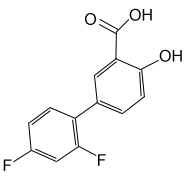Definition
Nonsteroidal anti-inflammatory drugs are medications other than corticosteroids that relieve pain, swelling, stiffness, and inflammation.
Purpose
Nonsteroidal anti-inflammatory drugs (NSAIDs) are prescribed for a variety of painful conditions, including arthritis, bursitis, tendinitis, gout, menstrual cramps, sprains, strains, and other injuries.
Description
The nonsteroidal anti-inflammatory drugs are a group of agents inhibiting prostaglandin synthetase, thereby reducing the process of inflammation. As a group, they are all effective analgesics. Some, including the salicylates, ibuprofen, and naproxene, are also useful antipyretics (fever-reducers).
Although the NSAIDs fall into discrete chemical classes, they are usually divided into the nonselective NSAIDs and the COX-2 specific agents. Among the nonspecific NSAIDs are diclofenac (Voltaren), etodolac (Lodine), flurbiprofen (Ansaid), ibuprofen (Motrin, Advil, Rufen), ketorolac (Toradol), nabumetone (Relafen), naproxen (Naprosyn), naproxen sodium (Aleve, Anaprox, Naprelan), and oxaprozin (Daypro). The COX-2 specific drugs are celecoxib (Celebrex) and rofecoxib (Vioxx).
Nonselective NSAIDS inhibit both cyclooxygenase 1 and cyclooxygenase 2 (COX-2). Cyclooxygenase 1 is important for homeostatic maintenance, such as platelet aggregation, the regulation of blood flow in the kidney and stomach, and the regulation of gastric acid secretion. The inhibition of cyclooxygenase 1 is considered the primary cause of NSAID toxicity, including gastric ulceration and bleeding disorders. COX-2 is the primary cause of pain and inflammation. Note that both celecoxib and rofecoxib are relatively selective, and may cause the same adverse effects as the nonselective drugs, although with somewhat reduced frequency.
The analgesic activity of NSAIDs has not been fully elucidated. Antipyretic activity may be caused by the inhibition of prostaglandin E2 (PGE2) synthesis.
Although not all NSAIDs have approved indications for all uses, as a class, they are used for:
- ankylosing spondylitis
- bursitis
- fever
- gout
- headache
- juvenile arthritis
- mild to moderate pain
- osteoarthritis
- PMS
- primary dysmennorhea
- rheumatoid arthritis
- tendinitis
Recommended dosage
Recommended doses vary, depending on the patient, the type of nonsteroidal anti-inflammatory drug prescribed, the condition for which the drug is prescribed, and the form in which it is used. Consult specific sources for detailed information.
Precautions
The most common hazard associated with NSAID use is gastrointestinal intolerance and ulceration. This may occur without warning, and is a greater risk among patients over the age of 65. The risk appears to rise with increasing length of treatment and increasing dose. Patients should be aware of the warning signs of gastrointestinal (GI) bleeding.
Allergic reactions are rare, but may be severe. Patients who have allergic reactions to aspirin should not be treated with NSAIDs.
Because NSAID metabolites are eliminated by the kidney, renal toxicity should be considered. Clinicians should monitor kidney function before and during NSAID use.
Among the NSAIDs that are classed as pregnancy category B are ketoprofen, naproxen, naproxen sodium, flurbiprofen, and diclofenac. Etodolac, ketorolac, mefenamic acid, meloxicam, nabumetone, oxaprozin, tolmetin, piroxicam, rofecoxib, and celecoxib are category C. Breastfeeding is not advised while taking NSAIDs.
Many other rare but potentially serious adverse effects have been reported with NSAIDs. Consult specific references.
Interactions
Many drug interactions have been reported with NSAID therapy. The most serious are those that may affect the bleeding hazards associated with NSAIDs. A partial list of interacting drugs follows. Consult specific references for further information.
- blood thinning drugs, such as warfarin (Coumadin)
- other nonsteroidal anti-inflammatory drugs
- heparin
- tetracyclines
- cyclosprorine
- digitalis drugs
- lithium
- phenytoin (Dilantin)
- zidovudine (AZT, Retrovir)
Common nonsteroidal anti-inflammatory drugs (NSAIDs)Generic name (trade name)Comparison to other NSAIDs
Aspirin (many trade names)Most widely used NSAID for analgesic and anti-inflammatory
effects; also used frequently for antipyretic and anticoagulant effects.
Diclofenac (Voltaren)Substanially more potent than naproxen and several other
NSAIDs; adverse side effects occur in 20% of patients.
Diflunisal (Dolobid)Has potency 3-4 times greater than aspirin in
terms of analgesic and anti-inflammatory effects but lacks antipyretic activity.
Etodolac (Lodine)Effective as analgesic/anti-inflammatory agent with
fewer side effects than most NSAIDs; may have gastric-sparing activity.
Fenoprofen (Ansaid)Similar to aspirin's benefits and side effects; also
available as topical ophthalmic preparation (Ocufen).
Ibuprofen (Motrin, Rufen, others)First nonaspirin NSAID also available in nonprescription
form; fewer GI side effects than aspirin but GI effects still occur in 5-15%
of patients.
Indomethacin (Indameth, Indocin)Relative high incidence of dose-related side effects;
problems occur in 25-50% of patients.
Ketoprofen (Orudis)Similar to aspirin's benefits and side effects but has
relatively short half-life (1-2 h).
Ketorolac (Toradol)Can be administered orally or by intramuscular injection;
parenteral doses provide postoperative analgesia equivalent to opioids.
Nabumetone (Relafen)Effective as analgesic/anti-inflamatory agent with fewer
side effects than most NSAIDs.
Naproxen (Anaprox, Naprosyn)Similar to ibuprofen in terms of benefits and adverse
effects.
Adapted from Rothstein, J.M., S.H. Roy, and S.L. Wolf. The Rehabilitation Specialist's Handbook. 2nd ed. Philadelphia: F.A. Davis Co., 1998.
Key Terms
- Bursitis
- Inflammation of the tissue around a joint.
- Inflammation
- Pain, redness, swelling, and heat that usually develop in response to injury or illness.
- Salicylates
- A group of drugs that includes aspirin and related compounds. Salicylates are used to relieve pain, reduce inflammation, and lower fever.
- Tendinitis
- Inflammation of a tendon-a tough band of tissue that connects muscle to bone.



